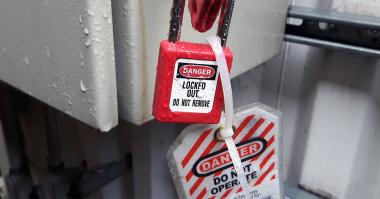
OSHA Top Citied Standards
Occupational Safety and Health Administration (OSHA), the top 10 most frequently cited standards
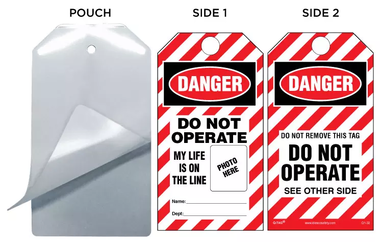
Making Your Own OSHA Standard Lockout Tags has Never Been Easier
There are a few rules in business and industry that are golden mantras to live by. First, the pursuit of profit is always a noble venture. Second, pursuing that profit at the expense of angering OSHA is never worth it. If there were a mantra that trumped both of prior, it would be that unnecessarily risking the live of your employees in the pursuit of profit is never worth it. There are risky jobs, to be sure, but casually treating employee safety like another line item expenditure has both moral and business implications. Here at Idesco Safety, we’ve made both the business decisions the passionate American entrepreneur has to make and the safety of our fellow Americans paramount. There is an economical way to ensure that a machine isn’t charged with energy when lives are at the risk and that also makes OSHA happy. Introducing the Peel-N-Stick P-Tag and the Self-Laminated Q-Tag.
continue reading
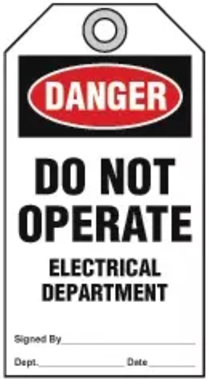
Electrical Safety In The Workplace
The Electrical
Safety Foundation International (EDFI) has designated May as National Electrical
Safety Month. On average, there are more than 300 deaths and over 4,000
injuries per year caused by Electrical Hazards in workplaces here in the United
States. Over 60% of the injuries are due to electric shock, the remainder
caused by electric burns. Electric shock is caused by either direct or indirect
contact with a conductive part that is energized. Electrical arcing, explosions
or fire result in burns. Toxic gases released as a result of fire as well as
the burning of electrical equipment often leads to severe illness or death.

Locking Out Valves During Maintenance
A number of various chemicals, hot or cold water as well as steam can cause serious injury to a worker performing maintenance. According to the OSHA regulation 1910.147, “The Control of Hazardous Energy” (Lockout/Tagout) all sources of energy to include, hydraulic, pneumatic, chemical and thermal must be locked out during a maintenance operation. To help satisfy that requirement, devices have been developed to insure that both liquids and gases are securely locked out.
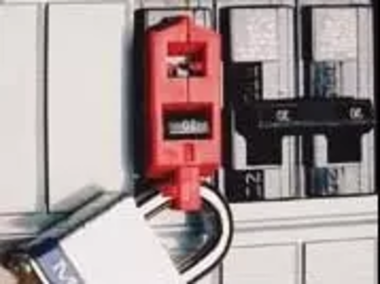
Circuit Breaker Lockouts
Within the OSHA Lockout:Tagout regulation, 1910.147 is this prominent paragraph: The Definition of an Energy Isolating Device: A mechanical device that physically prevents the transmission or release of energy, including but not limited to the following: A manually operated electrical circuit breaker; a disconnect switch; a manually operated switch by which the conductors of a circuit can be disconnected from all ungrounded supply conductors and, in addition no pole can be operated independently; a line valve; a block and any similar device used to block or isolate energy. Push buttons, selector switches and other control circuit type devices are not energy isolating devices. This has led to a myriad of circuit breaker lockout solutions. Factories throughout the United States, in fact the world, now have a variety of lockout solutions for their single pole and multi-pole circuit breakers.
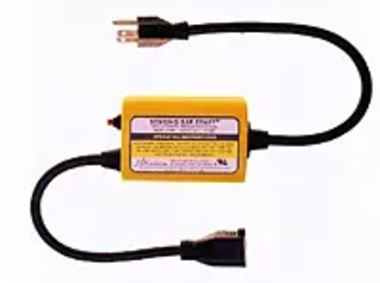
Preventing an automatic restart with safe start devices
Often times electrical equipment being used in a factory operation may suddenly shut down. This may be due to an internal power malfunction, a local power plant problem, a sudden jam in a gear, just to name a few. When this type of unintentional shut down takes place, it is extremely important to insure that the equipment does not suddenly start up again. Such an event may catch employees by surprise and lead to a serious accident. The Sensing Saf-Start device automatically “opens” the circuit once there is a sudden power loss. The circuit will remain “open” as long as the equipment power switch is “on.” Once the power switch is turned “off”, the Sensing Saf-Start device will then close the circuit. At that point, with everyone aware that the equipment can now be safely restarted, the power switch can be turned “on” and normal operation resumed.
continue reading

Lock Wrap Labels for Padlocks
In September of 1989, The OSHA Lockout:Tagout Regulation CFR1910.147 went into effect. It clearly stated that equipment being serviced had to be completely shut down and had to be both "Locked Out" and "Tagged Out" (with the tag firmly attached to the lock) clearly identifying the person or persons involved in that servicing operation. Furthermore, to insure the tag could not inadvertently slip off, tear off or somehow be removed from the padlock, both the tag and the device used to attach it to the padlock had to be strong enough to "pull" 50 pounds. And thus, the LockWrap(R) Padlock Label was created. The LockWrap acts as a tag and is wrapped securely around the padlock and cannot be removed.
continue reading

Fuse Blockouts and Latchouts
Section (c) (5)(i) of Lockout Regulation CFR 1910.147 states that Locks, tags, chains, wedges, key blocks, adapter pins, self-locking fasteners, or other hardware shall be provided by the employer for isolating, securing or blocking of machines or equipment from energy sources. Fuse holders and fuse panels are types of energy systems that are difficult to lockout. In order to satisfy the OSHA rule, devices have been devised that “blockout and “latchout” these energy sources. These devices keeps the electrical energy systems “OPEN” with no way for electrical energy to be reconnected. However, as there is no latch on these devices, there not be a padlock to insure that these devices will not be removed.
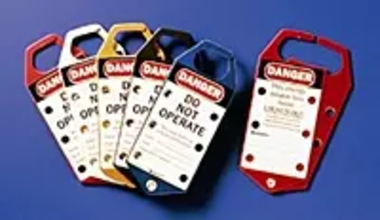
Idesco Safety’s Label Lockout Hasps
In many industrial zones and factories, employers are required by law to establish and implement a lockout/tagout program as mandated by OSHA. Workers performing service or maintenance on machinery and equipment may be exposed to injuries from the unexpected energy start up of the machinery or equipment, or release of stored energy in the equipment. The purpose of this program is to raise awareness of workplace safety and prevent accidents and injuries from occurring on the job.
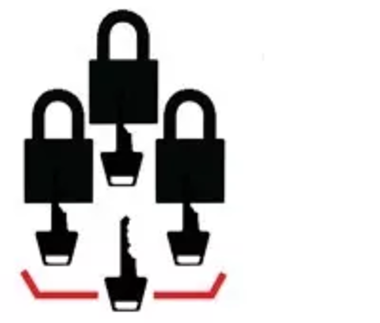
Proper Padlock Keying for Lockout:Tagout
Proper Padlock Keying for Lockout:Tagout
The OSHA Lockout:Tagout regulation CFR1910.147 states that Lockout Device is: A device that utilizes a positive means such as a lock, either key or combination type, to hold an energy isolating device in the safe position and prevent the energizing of a machine or equipment
Padlocks, usually combined with a specific type of lockout device such as a circuit breaker lockout or gate valve lockout insure that machinery cannot be in operation during a lockout:tagout situation. In fact a lockout:tagout operation will not begin until all machinery and equipment involved is locked out by the appropriate device and the appropriate lock.
There are basically 3 ways that padlocks are configured for Lockout:Tagout operations.
Padlocks can be set up “Keyed Alike.” In this situation more than one padlock being used has the same key set to open the locks Padlocks can be set up “Keyed Differently.” In this situation a number of padlocks being used have different key sets. So only a key for a specific padlock will open only that padlock and no other. Padlocks can also be set up to be “Master Keyed.” In this case, one or more persons, perhaps the supervisors will a key that will open many if not all padlocks being used, regardless of whether they are keyed alike or keyed differently.

Lockout Hasps
A lockout hasp is used when more than one employee is involved in a lockout:tagout operation. These employees work in a group on the same energy source. The hasps allow multiple padlocks to be used when isolating one energy source such as a piece of machinery or a power switch. The lockout hasp is placed through a latch on the machinery to be locked out and each person carrying out maintenance or service work attaches their padlock through one of the six openings within the lockout hasp. All of the padlocks are then locked.
continue reading

Laminated Safety Tags: Real Life Tags
Lamination provides the ultimate protection for mass-produced safety tags. Idesco Safety has a wide selection of OSHA approved laminated safety tags designed to withstand tough, dirty and greasy conditions. The durable polyester laminate resists water, grease and extreme temperatures. These laminated safety tags are easy to use. Simply attach these custom safety tags to machines, equipment and other devices to warn of dangers and communicate status.

Plug and Switch Lockouts
Lockouts are also known as “tag outs,” and hence the term lockout/tag out is often seen in tandem. A lockout/tag out refers to a procedure whereby a company assigns an individual to shut down power and disconnect all equipment and machinery from its primary energy source. The reason for doing so is in an emergency when becoming necessary to prevent the unexpected activation of that machinery as a means to protect workers and employees. The assigned employee then activates the energy-isolation (lockout/tag out) devices in a safe or “off” position.
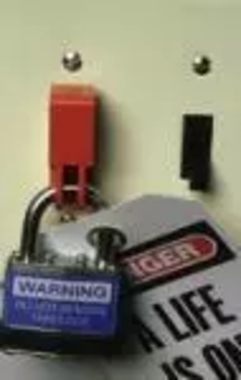
Plug and Switch Lockouts
Employees can find themselves at risk of a serious injury or death if the machine they operate starts up unexpectedly or releases stored but hazardous energy. It is the sole responsibility of employers to address safety issues that concern the safety of the employees, especially when handling with dangerous equipment.
Procedures and standards must be in place to disable machinery and prevent the release of perilous energy while maintenance and servicing a machine. These measures may include the use of a multi-step startup procedure, time delays, or audible warnings. In such relatively uncommon situations, lockout/tagout requirements do not apply. However, such alternative precautions must be carefully evaluated for their effectiveness in light of the configuration of the machinery, the reliability of the alternative measures, employee training, and other factors.